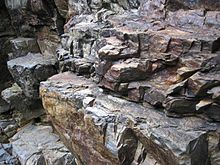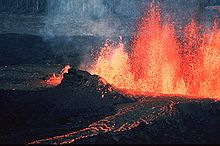Earth science
[1] This is a branch of science dealing with the physical, chemical, and biological complex constitutions and synergistic linkages of Earth's four spheres: the biosphere, hydrosphere/cryosphere, atmosphere, and geosphere (or lithosphere).[4] Plate tectonics, mountain ranges, volcanoes, and earthquakes are geological phenomena that can be explained in terms of physical and chemical processes in the Earth's crust.[6] Beneath the Earth's crust lies the mantle which is heated by the radioactive decay of heavy elements.As the result of seafloor spreading, new crust and lithosphere is created by the flow of magma from the mantle to the near surface, through fissures, where it cools and solidifies.Atmospheric chemistry was developed in the 20th century to measure air pollution and expanded in the 1970s in response to acid rain.In all, the atmosphere is made up of about 78.0% nitrogen, 20.9% oxygen, and 0.92% argon, and small amounts of other gases including CO2 and water vapor.[15] Water vapor and CO2 cause the Earth's atmosphere to catch and hold the Sun's energy through the greenhouse effect.In addition to trapping heat, the atmosphere also protects living organisms by shielding the Earth's surface from cosmic rays.Applied hydrogeology seeks to prevent contamination of groundwater and mineral springs and make it available as drinking water.The earliest exploitation of groundwater resources dates back to 3000 BC, and hydrogeology as a science was developed by hydrologists beginning in the 17th century.A foundational idea in Earth science is the notion of uniformitarianism, which states that "ancient geologic features are interpreted by understanding active processes that are readily observed."


( image not to scale. )


Costa Ricanatural sciencebiospherehydrospherecryosphereatmospheregeospherelithosphereplanetary sciencesedimentary rockMakhtesh RamonGeologygeothermal energyHistorical geologyEarth historyGeochemistryGeophysicsPaleontologyPlanetary geologyGeomorphologyStructural geologyEnvironmental geologyMineralogycrystal structurePetrologyPetrographyvolcanicStructure of EarthPlate tectonicsmountain rangesvolcanoesearthquakesgeologicalmantleradioactive decayheavy elementstransformseafloor spreadingsubductionasthenosphereAtmospheric sciencemagnetospheresolar windmeteorologyAtmospheric chemistryair pollutionacid rainClimatologyclimateclimate changetropospherestratospheremesospherethermosphereexospherenitrogenoxygengreenhouse effectcosmic raysmagnetic field4.5 billionEarth's magnetic fieldEarth's interiorcharged particleselectric currentsconvection currentsnickelEarth's outer coregeodynamomagnetic dipoleEarth's rotationalbar magnetNorth geomagnetic poleEllesmere IslandNunavutSouth geomagnetic polemagnetic polescompassesEarth's field reversesSouth Magnetic Polesgeomagnetic polespaleomagnetistsgeospaceionosphereozone layerHydrologywater cyclemovement of water on Earthoceanographyhydrogeologyecohydrologyglaciologygroundwatermineral springsdrinking waterglaciersEcologynutrientsPhysical geographyEarth's systemshuman geographyMethodologieshot spotuniformitarianismNature timelineReionizationAccelerated expansionSingle-celled lifePhotosynthesisMulticellularlifeVertebratesEarliest UniverseEarliest galaxyquasarblack holeOmega CentauriAndromeda GalaxyNGC 188 star clusterAlpha CentauriSolar SystemEarliest known lifeEarliest oxygenAtmospheric oxygenSexual reproductionEarliest fungiEarliest animals
